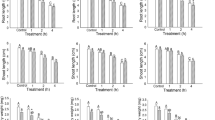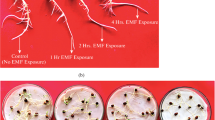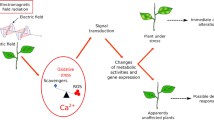Abstract
The present study investigated the impact of 1800-MHz electromagnetic field radiations (EMF-r), widely used in mobile communication, on the growth and activity of starch-, sucrose-, and phosphate-hydrolyzing enzymes in Zea mays seedlings. We exposed Z. mays to modulated continuous wave homogenous EMF-r at specific absorption rate (SAR) of 1.69±0.0 × 10−1 W kg−1 for ½, 1, 2, and 4 h. The analysis of seedlings after 7 days revealed that short-term exposure did not induce any significant change, while longer exposure of 4 h caused significant growth and biochemical alterations. There was a reduction in the root and coleoptile length with more pronounced effect on coleoptile growth (23 % reduction on 4-h exposure). The contents of photosynthetic pigments and total carbohydrates declined by 13 and 18 %, respectively, in 4-h exposure treatments compared to unexposed control. The activity of starch-hydrolyzing enzymes—α- and β-amylases—increased by ∼92 and 94 %, respectively, at an exposure duration of 4 h, over that in the control. In response to 4-h exposure treatment, the activity of sucrolytic enzymes—acid invertases and alkaline invertases—was increased by 88 and 266 %, whereas the specific activities of phosphohydrolytic enzymes (acid phosphatases and alkaline phosphatases) showed initial increase up to ≤2 h duration and then declined at >2 h exposure duration. The study concludes that EMF-r-inhibited seedling growth of Z. mays involves interference with starch and sucrose metabolism.

Similar content being viewed by others
References
Agoreyo BO (2010) Acid phosphatase and alkaline phosphatase activities in ripening fruit of Musa paradisiaca L. Plant Omics J 3:66–69
Akbal A, Kiran Y, Sahin A, Turgut-Balik D, Balik HH (2012) Effects of electromagnetic waves emitted by mobile phones on germination, root growth, and root tip cell mitotic division of Lens culinaris medik. Pol J Environ Stud 21(1):23–29
Andreuccetti D, Fossi R, Petrucci C (1997) An internet resource for the calculation of the dielectric properties of body tissues in the frequency range 10 Hz–100 GHz. http://niremfifaccnrit/tissprop/Florence, (Italy): IFAC-CNR; Based on data published by C Gabriel et al. in 1996
Arnon DI (1949) Copper enzymes in isolated chloroplasts: polyphenol oxidase in Beta vulgaris. Plant Physiol 24:1–15
Belyavskaya NA (2004) Biological effects due to weak magnetic field on plants. Adv Space Res 34:1566–1574
Bernfeld P (1955) Amylases, α and β. Methods Enzymol 1:149–158
Bradford MM (1976) Rapid and sensitive method for the quantitation of microgram quantities of protein utilizing the principle of protein-dye binding. Anal Biochem 72:248–254
Canli O, Erdal S, Taskin M, Kurbanoglu EB (2011) Effects of extremely low magnetic field on the production of invertase by Rhodotorula glutinis. Toxicol Ind Health 27:35–39
Çenesiz M, Atakişi O, Akar A, Önbilgin G, Ormancı N (2011) Effects of 900 and 1800 MHz electromagnetic field application on electrocardiogram, nitric oxide, total antioxidant capacity, total oxidant capacity, total protein, albumin and globulin levels in guinea pigs. J Fac Vet Med Univ Kafkas 17(3):357–362
Cucurachi S, Tamis WLM, Vijver MG, Peijnenburg WJGM, Bolte JFB, de Snoo GR (2013) A review of the ecological effects of radiofrequency electromagnetic fields (RF-EMF). Environ Int 51:116–140
Duff SMG, Sarath G, Plaxton WC (1994) The role of acid phosphatase in plant phosphorus metabolism. Physiol Plant 90:791–800
Dure LS (1960) Site of origin and extent of activity of amylases in maize germination. Plant Physiol 35:925–934
Fiske CH, Subbarow Y (1952) The colorimetric determination of phosphorus. J Biol Chem 56:375
Flórez M, Carbonell MV, Martínez E (2007) Exposure of maize seeds to stationary magnetic fields: effects on germination and early growth. Environ Exp Bot 59:68–75
Goldsworthy A (2006) Effects of electrical and electromagnetic fields on plants and related topics. In: Volkov AG (ed) Plant electrophysiology—theory and methods. Springer, Berlin Heidelberg, pp 247–267
Goodman EM, Greenebaum B, Marron MT (1995) Effects of electromagnetic fields on molecules and cells. Int Rev Cytol 158:279–338
Hajnorouzi A, Vaezzadeh M, Ghanati F, Jamnezhad H, Nahidian B (2011) Growth promotion and a decrease of oxidative stress in maize seedlings by a combination of geomagnetic and weak electromagnetic fields. J Plant Physiol 168:1123–1128
Halgamuge M, See K, Eberhardt J (2015) Reduced growth of soybean seedlings after exposure to weak microwave radiation from GSM 900 mobile phone and base station. Bioelectromagnetics 36:87–95
Hanafy MS, Mohamed HA, Elham A, El-Hady EAA (2006) Effect of low frequency electric field on growth characteristics and protein molecular structure of wheat plant. Rom J Biophys 16:253–271
Hirano MH, Ohta A, Abe K (1998) Magnetic field effects on photosynthesis and growth of the cyanobacterium Spirulina platensis. J Ferment Bioeng 86:313–316
Hiscox JD, Israelstem GF (1979) A method for the extraction of chlorophyll from leaf tissue without maceration. Can J Bot 57:1332–1334
Kaplan F, Guy CL (2004) β-amylase induction and the protective role of maltose during temperature shock. Plant Physiol 135:1674–1684
Khalafallah AA, Sallam SM (2009) Response of maize seedlings to microwaves at 945 MHz. Rom J Biophys 19:49–62
Khurana VG, Hardell L, Everaert J, Bortkiewicz A, Carlberg M, Ahonen M (2010) Epidemiological evidence for a health risk from mobile phone base stations. Int J Occup Environ Health 16(3):263–267
Kouzmanova M, Dimitrova M, Dragolova D, Atanasova G, Atanasov N (2009) Alterations in enzyme activities in leaves after exposure of Plectranthus sp. plants to 900 MHz electromagnetic field. Biotechnol Biotechnol Equip 23(2):611–615
Kundi M (2009) The controversy about a possible relationship between mobile phone use and cancer. Environ Health Perspect 117:317–324
Li SH, Chow KC (2001) Magnetic field exposure induces DNA degradation. Biochem Biophys Res Commun 280(5):1385–1388
Loewus FA (1952) Improvement in anthrone method for determination of carbohydrates. Anal Chem 24:219
Mahajan P, Singh HP, Batish DR, Kohli RK (2013) Cr(VI) imposed toxicity in maize seedlings assessed in terms of disruption in carbohydrate metabolism. Biol Trace Elem Res 156:316–322
Malik CP, Singh MB (1980) Plant enzymology and histo-enzymology. Kalyani Publishers, New Delhi, India
Muentz K (1977) The function of the pod for protein storage in seeds of Vicia faba L. 5. Isoenzymes of α-amylase during pod development of field beans. Phytochemistry 16:1491–1494
Nelson N (1944) A photometric adaptation of the Somogyi method for the determination of glucose. J Biol Chem 153:375–380
Niittyla T, Messerli G, Trevisan M, Chen J, Smith AM, Zeeman SC (2004) A previously unknown maltose transporter essential for starch degradation in leaves. Science 303:87–89
Olmos E, Hellin E (1997) Cytochemical localization of ATPase plasma membrane and acid phosphatase by cerium based in a salt-adapted cell line of Pisum sativum. J Exp Bot 48:1529–1535
Peñuelas J, Llusiá J, Martínez B, Fontcuberta J (2004) Diamagnetic susceptibility and root growth responses to magnetic fields in Lens culinaris, Glycine soja, and Triticum aestivum. Electromagn Biol Med 23:97–112
Pollan M (2013) The intelligent plant. The New Yorker. Available online at URL: http://www.newyorker.com/magazine/2013/12/23/the-intelligent-plant
Rani D, Kohli RK (1991) Fresh matter is not an appropriate relation unit for chlorophyll content: experience from experiments on effects of herbicide and allelopathic substance. Photosynthetica 25:655–667
Ranwala AP, Miller WB (1998) Sucrose cleaving enzymes and carbohydrate pools in Lilium longiflorum floral organs. Physiol Plant 103:541–550
Roitsch T, Gonzalez MC (2004) Function and regulation of plant invertases: sweet sensations. Trends Plant Sci 9:606–613
Rosa M, Hilal M, González JA, Prado FE (2004) Changes in soluble carbohydrates and related enzymes induced by low temperature during early developmental stages of quinoa (Chenopodium quinoa) seedlings. J Plant Physiol 161:683–689
Roux D, Vian A, Girard S, Bonnet P, Paladian F, Davies E, Ledoigt G (2007) High frequency (900 MHz) low amplitude (5 V m−1) electromagnetic field: a genuine environmental stimulus that affects transcription, translation, calcium and energy charge in tomato. Planta 227:883–891
Sandu DD, Goiceanu IC, Ispas A, Creanga I, Miclaus S, Creanga DE (2005) A preliminary study on ultra high frequency electromagnetic fields effect on black locust chlorophylls. Acta Biol Hung 56:109–117
Shabrangi A, Majd A (2009) Comparing effects of electromagnetic fields (60 Hz) on seed germination and seedling development in monocotyledons and dicotyledons. PIERS Proceedings, Moscow, Russia
Sharma VP, Singh HP, Kohli RK, Batish DR (2009) Mobile phone radiation inhibits Vigna radiata (mung bean) root growth by inducing oxidative stress. Sci Total Environ 407(21):5543–5547
Sharma VP, Singh HP, Batish DR, Kohli RK (2010) Cell phone radiations affect early growth of Vigna radiata (mung bean) through biochemical alterations. Z Naturforsh C 65(1–2):66–72
Singh HP, Sharma VP, Batish DR, Kohli RK (2012) Cell phone electromagnetic field radiations affect rhizogenesis through impairment of biochemical processes. Environ Monit Assess 184:1813–1821
Stanley D, Farnden KJF, MacRae EA (2005) Plant α-amylases: functions and roles in carbohydrate metabolism. Biologia (Bratislava) 16:65–71
Sturm A, Tang GQ (1999) The sucrose-cleaving enzymes of plants are crucial for development, growth and carbon partitioning. Trends Plant Sci 4:401–407
Taskin M, Esim N, Genisel M, Ortucu S, Hasenekoglu I, Canli O, Erdal S (2013) Enhancement of invertase production by Aspergillus niger OZ-3 using low-intensity static magnetic fields. Prep Biochem Biotechnol 43:177–188
ITU (International Telecommunication Union) (2015) ITU World Telecommunication/ICT Indicators database, 2014. Available online at URL: http://www.itu.int/en/ITU-D/Statistics/Documents/statistics/2015/ITU_Key_2005-2015_ICT_data.xlsPages/publications/wtidaspx. Accessed on May 24, 2015
Tkalec M, Malarić K, Pevalek-Kozlina B (2007) Exposure to radiofrequency radiation induces oxidative stress in duckweed Lemna minor L. Sci Total Environ 388:78–89
Tkalec M, Malarić K, Pavlica M, Pevalek-Kozlina B, Vidaković-Cifreka Z (2009) Effects of radiofrequency electromagnetic fields on seed germination and root meristematic cells of Allium cepa L. Mutat Res 672:76–81
Acknowledgments
The authors acknowledge the Ministry of Environment and Forests (India) and Department of Science and Technology (India) for financial assistance. Arvind Kumar is thankful to the University Grants Commission for providing research fellowship under UGC-BSR scheme.
Conflict of interest
The authors declare that they have no competing interests.
Author information
Authors and Affiliations
Corresponding author
Additional information
Handling Editor: Peter Nick
Rights and permissions
About this article
Cite this article
Kumar, A., Singh, H.P., Batish, D.R. et al. EMF radiations (1800 MHz)-inhibited early seedling growth of maize (Zea mays) involves alterations in starch and sucrose metabolism. Protoplasma 253, 1043–1049 (2016). https://doi.org/10.1007/s00709-015-0863-9
Received:
Accepted:
Published:
Issue Date:
DOI: https://doi.org/10.1007/s00709-015-0863-9




